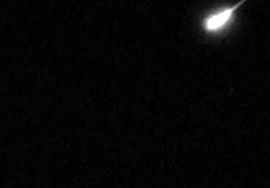 |
Home |
File a UFO Report |
View UFO Reports |
|
![]()
The Geminids: Meteors from the Twilight Zone
"The Geminids of mid-December are one of the best annual meteor showers," says Bill Cooke of the NASA Space Environments Team at the Marshall Space Flight Center. Geminid meteors are bright, plentiful, and sky watchers can see them from both hemispheres. And that's not all..."I enjoy the Geminids because they come from the Twilight Zone," he laughs.
Meteor showers are supposed to come from comets. "Comets are big chunks of ice mixed with some amount of dust and rock," explains Cooke. When they swing by the Sun, the ice evaporates; clouds of dust and gas spew into space--"that's why comets have tails," he says.
| Right : Amateur astronomer George Varros photographed this Geminid fireball on Dec. 7, 2002. "It was as bright as Venus," says Varros. |
 |
But 3200 Phaethon doesn't act like a comet, says Cooke. "3200 Phaethon doesn't sprout a tail when it comes close to the Sun. It doesn't have a halo or a coma ... in fact, based on its orbit and the way it reflects sunlight, it seems much more like an asteroid."
Perhaps, he speculates, it's a little bit of both.
"It has become quite obvious in recent years that our nomenclature in astronomy is not keeping pace with our discoveries. We like to place objects in neat well-defined categories even though Mother Nature makes no such distinctions. For instance, is Pluto a planet or a Kuiper-belt asteroid? When does a Jupiter-like planet become a brown dwarf?"
Likewise, he asks, "after a comet has gone around the Sun so many times that its ices are exhausted, so that it no longer has a tail or a coma, is it still a comet? Or do we re-classify it as an asteroid?"
Phaethon may well be a "Twilight Zone" object--intermediate between asteroids and comets. "That's my opinion," says Cooke. "3200 Phaethon was once an active comet, but about 1000 years ago the last of its ices evaporated." Indeed, dynamical studies by Bo Gustafson and colleagues at the University of Florida show that Geminid meteoroids are about 1000 years old. "Now," he adds, "all that's left is a rocky comet corpse."
An asteroid, a comet, a comet corpse? The meteors are lovely no matter what.
Geminid meteors stream out of the constellation Gemini--hence their name. Try looking for them on Saturday, Dec. 13th, between 10 p.m. local time and midnight. During those hours the moon won't be too high or glaring, and you should be able to spot dozens of meteors.